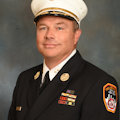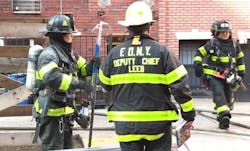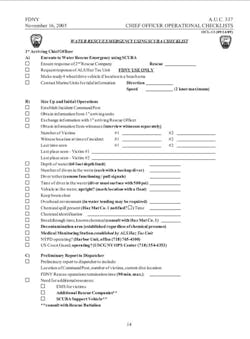The incident commander (IC) must manage successfully and proficiently the many responsibilities of command, to best fulfill the fire service core mission of life and property preservation. These responsibilities include everyday responses, such as structural fires, calls to help the sick and injured, alarms ringing, odors of smoke or gas and automobile accidents, to name a few. However, they also include and extend to everything else that the public calls upon us to help to solve. These are awesome responsibilities that we must be prepared for.
The tools of the chief officer or IC are vastly different from those of the irons or nozzle firefighter. The firefighter who occupies the nozzle or irons position must be proficient at stretching the hoseline or forcing a door, respectively. The IC must have a wider aperture/more global view of all of the aspects of an incident. Thus, the tools of the IC are different and are intended to facilitate the IC in command and control, firefighter accountability (knowing where everyone is), resource allocation, victim tracking, and, of course, developing and implementing strategy. It’s the strategy that leads to the implementation of tactics, such as the forcing of a door.
The humble clipboard
When I was a new battalion chief attending FDNY’s battalion chief command course, many highly respected and seasoned veteran chiefs lectured on various topics. At some point, almost all of them spoke about the importance of carrying a clipboard or something else that’s capable of holding forms or other documents that assisted them as the IC.
For me, it was an aluminum clipboard that had a low-profile metal clip to hold papers in place, a hinged writing plate to keep one or two papers and a small storage compartment that could hold the several organized documents that I carried.
I also had a pencil, because a pencil usually is more reliable than a pen, particularly in less-than-ideal weather conditions. It also was small enough that it could fit into my bunker coat pocket when it wasn’t needed or when I was assigned to an inside position. (In FDNY, the first battalion chief on scene typically stays outside in front of the structure, in command of the operations, while the second battalion chief often goes to the fire floor sector and commands operations of that sector from an advantageous location inside of the structure. When the deputy arrives, the first battalion chief and the deputy chief remain at the command post and in command.)
My aluminum clipboard was worth its weight in gold, because it was incredibly useful and provided me with a convenient place to take notes when needed or to keep track of the many units that were on a second-alarm fire.
Over time, I added many homemade cheat sheets that I would adjust several times to help me to better fulfill my job responsibility. This was particularly true as a new battalion chief who learned from every response.
A living document
Of course, the IC should easily be able to mentally keep track of a few operating units. However, as an incident escalates and additional units are put to work, the situation becomes increasingly challenging to manage.The IC must be forward-thinking and proactively plan for and prepare for the possibility of an incident escalating. This forward-thinking planning is no different than the early positioning of tower ladders in front of a taxpayer or strip mall for the possibility of the incident escalating. This is where a form or checklist becomes an important IC tool.
Once, when we had a fire on a lower floor of a high-rise residential structure, I forgot to confirm with on-scene units that the elevators were searched. Because FDNY typically doesn’t use the elevators for a lower-floor fire, I simply forgot to confirm that they were checked. Sure enough, the deputy chief arrived and asked me whether the elevators were searched. Although it turned out that they were searched, I wasn’t able to provide the information when it was requested.
I learned from this, and it made me better. It also resulted in me adding a bullet point to my cheat sheet for working high-rise residential fires—simply reminding me to confirm that elevators were searched.
This working fire sheet also had an area to record where hoselines were operating, where units were searching and what units were assigned to these tasks.
It also had an area where I was able to write down apartment numbers that were relayed from the dispatcher that needed to be searched. Without writing them down, it’s nearly impossible while effectively running a fire to remember six, seven or more apartment numbers and then recall and track which apartments were searched or need to be searched.
As any experienced IC can tell you, as an incident escalates and more firefighters operate inside of the structure, it becomes increasingly difficult to track all of the resources that are on scene.
From routine to complex
The sheet that I used for working fires was adapted from several versions that I saw and was designed in a way that made it easy for me to change it over time to adjust for my personal style and tendencies. I also developed simple lists of bullet points to assist on routine investigations or assignments, such as a list of information that I needed to collect when I investigated an apparatus collision.
Having all of my documents saved on the computer made any modifications to my homemade forms easy to do. It also ensured that I didn’t miss anything.
Uncommon & high-risk
Today, I have been a chief officer for nearly 12 years and have been an officer for almost 20. However, I am keenly aware that in the heat of the moment it still is easy to miss steps, particularly when the incident expands or at an uncommon or infrequent response.
This is quite true for high-risk and high-consequence incidents, because we don’t get many repetitions to convert experiences and training into muscle memory.
Add on the early, chaotic, stressful moments of an infrequent response, and the ease by which one can overlook or miss a step or task becomes even clearer. A step or task could be simply remembering to set up a triage and transportation point at an aircraft emergency or implementing a street management plan at a building collapse, or it could be as complex as ensuring that the proper response is called for at a radiological incident or setting up proper communications when a train derails 100 feet underground.
To assist the IC, FDNY has checklists for many low-probability/high-consequence responses. As part of FDNY’s effort to improve safety, efficiency and operating procedures, chief officer operational checklists were created to assist chief officers in managing major incidents.
Currently, there are 17 checklists: aircraft emergency checklist and tarmac guide, building collapse, chemical incidents, confined space, explosions, hazmat incidents, high-angle emergencies, MTA New York City transit liaison, major gas emergency, maydays, radiological incidents, search checklist delayed/unable to complete, ship fire, suspicious package/confirmed device, under-river rail operations, under-river rail operations safety and water rescue emergency using SCUBA.
During my time as an IC at the battalion and deputy chief ranks, these checklists and the other documents that I kept on my clipboard served me well. This largely is because I had a depth of knowledge and familiarity with the checklists and the other documents as well as a deep understanding of FDNY procedures. Although it wasn’t necessary to use the contents of my clipboard or checklists at most fires, I always had it with me.
When I used the checklists, I did so after reviewing them numerous times, just as it’s important for firefighters to check the rig before their tour.
Attention to detail
It should go without saying that the clipboard and its contents never are a surrogate for fireground competence. The IC must be well trained and well educated and possess the knowledge, skills and ability to be a competent fireground commander.
However, a well-thought-out clipboard can provide a competent IC with a strategic advantage that’s similar to the tactical advantage that a thermal imaging camera gives a firefighter who is searching a structure when it’s banked down to the floor amid a report of people missing.
What do you do to best set up for success on the fireground? What’s on your clipboard? What do you do to best respond and perform when the incident unexpectedly expands or for the infrequent incidents?
As the IC, you have the awesome responsibility for every firefighter who is on scene. You should employ every possible tool to give you a strategic advantage. Just as chiefs expect firefighters to be prepared, firefighters expect their IC to be prepared. We owe every firefighter on the fireground this preparation and attention to detail.
The Electronic Clipboard
FDNY has an incident command app that, in the past few years, has become an electronic clipboard. Installed on all FDNY iPads and cellphones, the app provides an exceptional strategic advantage to the incident commander (IC).
On second-alarm incidents, FDNY has a Field Communications unit and Resource Unit Leader (battalion chief) that respond and assist the IC with communications and unit tracking.
About the Author

Frank Leeb
Frank Leeb is the managing director of the First Responder Center for Excellence. He previously served as a deputy assistant chief in FDNY, retiring in June 2024 after more than 31 years. During his tenure with FDNY, Leeb held several senior staff positions, including chief of the fire academy, chief of training and chief of safety. He also has been a member of the East Farmingdale, NY, Volunteer Fire Department since 1983. Leeb holds a bachelor's degree in fire service administration from SUNY Empire State and a master’s degree in security studies from the Naval Postgraduate School, Center for Homeland Defense and Security. He served as an advisory panel member for UL's Fire Safety Research Institute's "Study of Coordinated Fire Attack Utilizing Acquired Structures" and was the keynote speaker for Firehouse Expo in 2022 and FireFusion 2024. Leeb is the author of "Cornerstones of Leadership: On and Off the Fireground." He was a presenter at the 2022 and 2023 U.S. Fire Administrator Summit on Fire Prevention and Control. Leeb can be contacted at [email protected].

